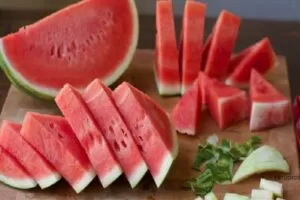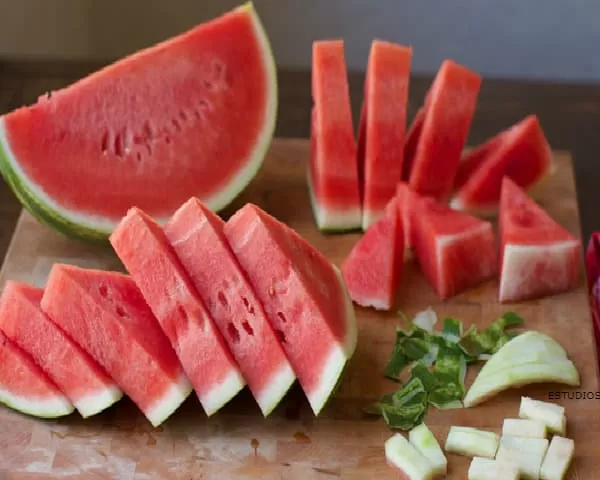The watermelon or sideburn, is a fruit that belongs to the classification of both aphrodisiacs and summer fruits. It is a food rich in water, capable of keeping people hydrated during the day. Not only do they serve as great allies of hydration, but they also provide the body with interesting amounts of vitamins A, C, E, magnesium and potassium, which are extremely rich in flavor and beneficial to the human body.
It is a fruit that is characterized mainly by its large size, in addition to its attractive colors, being its water content of almost 93% so it is an extremely refreshing fruit to keep people away from heat.
Origin of Watermelon
The origin of this incredible fruit is intertwined with the Kalahari desert, precisely in the African continent, where nowadays, watermelon continues to grow wild.
After having ascended the Nile, watermelon cultivation reached the Mediterranean Sea, where it began to be marketed by the riparian countries, such as Greece, Italy, Portugal and Spain. The watermelon arrives in America by the European settlers, spreading it all over the continent. Because of its unique roots, its cultivation adapted quickly in these places, since they fit within tropical or extremely hot climates, managing to go deep into the ground, allowing it to quickly absorb water from rain or morning dew.
In its beginnings, watermelon had a bitter taste, so it was impossible to be consumed by both inhabitants and animals of those regions. With the passing of time, the human being has been eliminating the bitter taste by means of the cultivation process, and selecting extremely sweet species. It was in the 10th century that the cultivation of watermelons arrived in China, causing a positive effect on the inhabitants of that region, so much so, that nowadays, they have as a custom and habitual social act, to give watermelons as a nice gift.
Watermelon Properties
Among the main properties of watermelon you get the following:
- Watermelon is widely known for its hydration property, since it is a relevant characteristic, being approximately between 90 and 95% of its weight constituted by water.
- Watermelon is a fruit with low caloric content, so it is extremely ideal for people who want to lose weight or reduce measures, contributing as a slimming property, which can be included in low-carb diets and obtain results in a healthy way.
- Watermelon has a high content of fibers, both soluble and insoluble, which allows accentuating its slimming property, since thanks to the amount of water it has, it produces sensations of satiety in the human body, which helps prevent people from consuming larger amounts of other foods.
- On the other hand, watermelon provides a high content of minerals and nutrients, finding mainly iron, which is an indispensable metallic mineral in the aerobic body. This mineral plays a fundamental role in the body and watermelon is able to serve as an easy way to supply it.
- Watermelon has anti-inflammatory properties, relieving pain in the body, improving circulation, reducing cholesterol, protecting the heart; it also works as an antioxidant and helps people lose weight effectively.
- Watermelon acts as an antioxidant property, thanks to its high content of vitamin C, which not only promotes the antioxidant effect but also stimulates the production of all the cells and molecules of the immune system.
Benefits of Watermelon
Among the main benefits of watermelon you get the following:
- Fruits like watermelon are responsible for providing the body with a long list of positive effects, thanks to the nutrients and phytochemicals they possess and which the human body needs on a regular basis.
- As watermelon is a fruit with high water content, it allows restoring the body’s hydration accordingly, keeping people in balance with the water level the body needs.
- Thanks to its high water content, watermelons help maintain totally healthy renal function, because they act as a highly diuretic or purifying fruit in the human body, eliminating all the toxins that are located.
- Watermelons have a proportion of dietary fiber, which helps stimulate digestion, facilitating the evacuation of feces obtained from the digestion process.
- In addition to supplying iron to the body, they are responsible for providing magnesium, potassium, and calcium,
- which can help maintain cellular metabolic activity, speeding up different processes required by the body.
- Watermelons, due to their high content of vitamins, protect and help maintain a good immune system, which is beneficial in preventing diseases and infections that can damage health.
Types of Watermelon
At present, there are different crops or types of watermelon, capable of being recognized worldwide, either by its agronomic characteristics, such as its large size, or color of the bark, shape, flavor, among others.
Among the main types of watermelon you can find the following:
Due to its rounded shape and extremely early cycle, there are: the early Catalan watermelons, the black pearl watermelons and the sugar baby watermelons, which predominate due to their robust bark, being of a dark green color.
Then, you get the yellow doll that are a little lighter green, having striations and being its pulp of intense yellow color; the rubin watermelons, also come in rounded form but its rind is of apple green color.
Now, the watermelons in the same way, rounded but, with medium-late cycles: Within this category you get the watermelon pileña, sweet of America, Imperial and Sayonara, which are dark with barks throwing black.
Watermelons that are elongated but with an early cycle: in this bouquet you get the striped klondike and prince charles watermelons, which are dark green and grayish, besides containing in its pulp small yellow seeds.
Nowadays, there are watermelons without seeds, which are well called queens of hearts, with round fruits and light green color, and the queens fummy, being round but green with extremely dark black color.
Watermelon Tree
This fruit, known as water melon, patilla or watermelon, grows from a climbing plant or so-called creeping plant, of which its family is the cucurbitaceae, where other crop species also belong.
The watermelon is born from a plant whose growth is similar, extending through the vegetation of the soil and climbing to the highest vegetation.
This herbaceous type of plant has an extremely rough texture, whose surface has a large number of structures which are usually called tendrils; these structures are the extensions of the stem, which serve as a clamp to hold different surfaces.
The tendrils it possesses, in the same way, are the reference point that differentiates these plants from others, and that people recognize that this is the watermelon tree, since they tend to cling to other plants or inanimate objects, so that the fruits that are born maintain their balance and serve as support for their growth.
On the other hand, the leaves that come out of this tree have 5 lobes, which are usually extremely deep, and are characterized by average sizes and fragile textures; the stem is a resistant structure, which is increasingly tested to support the full weight of each fruit produced.
Is Watermelon Fattening ?
Thanks to its high water content and the fact that watermelon represents a notorious amount of fiber, it can produce an immense satiety in the organism. However, people tend to confuse this fruit with a significant increase in weight due to the calories it provides.
Although watermelon has a caloric contribution of 32 kilocalories per 100 grams, which does not represent a high proportion in the body so that people tend to increase easily, on the contrary, it would be an ideal caloric contribution to include this rich fruit in weight loss diets.
Watermelon is a fruit that is used within the usual balanced food system which helps to promote the energy stored in the body, thus helping to reduce body mass and weight without you noticing.
Does Watermelon Have Fiber ?
Watermelon, besides being a fruit rich in water and vitamins A, C, E, B1 and B6, provides the body with a high amount of potassium and fiber, which can serve as the perfect food to include in slimming diets.
These fruits are highly recommended for people who suffer from kidney diseases, likewise, as they possess both soluble and insoluble fibers, they work as diuretic effects, capable of effectively eliminating, through urine, all the liquids that are retained in the body.
However, the watermelon is one of the fruits that although it has fibers, does not bring so many to the body, its amount is moderate, but does not cease to be enough to combat all the problems of constipation that may occur in the body, so in fact, also work as highly natural laxatives.
Does Watermelon Have Sugar ?
The answer is yes, however, the sugars that make up the carbohydrates in watermelon are mainly glucose and fructose, which are responsible for providing the energy needed for the activities to perform during the day.
Therefore, the little sugar that watermelon contains represents a low caloric proportion, which is ideal and perfect for people both diabetics and those who want to reduce weight to be able to consume them without any risk.
Does Watermelon Fatten if you Eat it at night ?
Watermelon, like the other fruits, does not tend to make people fat either during the day or at night. On the contrary, many of them work as perfect fat burners that help with digestion throughout the day, so that they can be included in an adequate manner in weight loss diets.
Is Watermelon Diuretic ?
Due to its ample water supply, watermelon becomes an excellent diuretic, resulting in a food indicated for people who tend to suffer from kidney stones, ailments related to fluid retention and high uric acid levels.
Watermelon will always promote the elimination of liquids and all toxic substances from the body, being a natural and highly purifying element.
Due to its high water content, it tends to be a heavy food, however, with the necessary daily doses, it provides fibers that help generate a satiating effect, as well as improving the different functions of the digestive system.
Is Watermelon Good for Digestion ?
Generally, watermelon is a very digestive fruit, however, it must be emphasized that doctors do not recommend ingesting them after meals, since in some people, due to their high water levels, they dilute the gastric juices, and therefore, would delay the digestion much more, causing feelings of indigestion.
The watermelon, in spite of everything, is a fruit highly recommended for the slimming diets, since if it is managed to consume a great portion of this rich fruit, the levels of calories in the stomach will be increased, but, being ideal for the system of balanced feeding.
Does Watermelon Get you Lose Weight ?
Watermelon is a fruit that is characterized by its high water content, in addition to its ease of consumption due to its incredible texture.
It is an ideal fruit to include in the balanced diet system on a regular basis, so that people can achieve their weight reduction goals in a healthier way.
In most cases, watermelon is introduced into slimming diets, which thanks to its nutritional properties, ensure that people do not have any complications with their diet, provides essential elements to the body and in most cases, are rich and satisfying.
Its low caloric level is what helps people to lose weight in a fast, effective and healthy way, since in theory, if it is able to contribute calories to the body, nevertheless, these work much more like fat burners which will help people to lose weight much faster.
Watermelon Calories
From the caloric point of view, watermelon is a fruit that does not represent a high value in terms of quantities of calories supplied to the body, on the contrary, it is a fruit that provides important levels of vitamins and minerals, indispensable for a totally balanced diet.
In addition, it provides potassium, vitamins A, C, E and magnesium, and is an important source of moisturizing foods, since thanks to the water it provides to the body, it is able to maintain the watery levels extremely intact, so it turns out to be a moisturizing fruit.
For every 100 grams of watermelon consumed, people will be acquiring an approximate value of 7.55 grams of carbohydrates, of which only a certain percentage is used as a highly energetic source.
On the other hand, the lipid and protein content of watermelon is scarcely reduced, so only its glycosidic content is normally taken into account as part of the necessary route for the energy source that the fruit provides daily.
So it remains to say that for every 100 grams of this fruit consumed, people will acquire in their body a total of only 30 or 32 kilocalories of energy. Therefore, in comparison with other fruits, it is one of the lowest indexes for the system of balanced feeding in a habitual way.
History of Watermelon
Watermelon, mainly began to be cultivated in Africa, then spread to Europe, the Middle East and culminating in India. Years later, its cultivation arrived in China and America, being one of the sensations for that time.
The first species that was born from this fruit is called Cucurbitaceae, which grew in the valleys of the Nile River. When it began to spread, the inhabitants planted it in Africa, dispersing it to the Mediterranean Sea.
The watermelon, arrives to America with the conquest of the New World, thanks to the colonizers that came from Italy, Portugal, Spain and Sweden.
Currently, Asia is the main source of watermelon production, with more than 80% of world production. Today, it is still being discussed what will be the true origin of the watermelon, however, it is a common fruit capable of impressing and making anyone taste it.
Topics Related to Fruits in ALPHAPEDIA

SOUR FRUITS: What They Are and Their Benefits for the Body

RASPBERRIES: Origin, Properties and Benefits
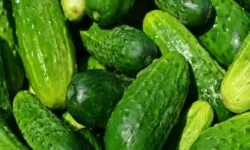
CUCUMBER: Fruit or Vegetable. Benefits and Properties

AVOCADO: Origin, Properties, Meaning and Benefits
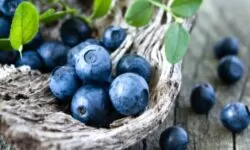
BLUEBERRIES: Benefits, Properties and Contraindications

WINTER FRUITS: Benefits and Properties
Health and Wellness Issues at ALPHAPEDIA

BANANA: Benefits, Properties and Contraindications

ZUCCHINI: Properties, Benefits and Characteristics
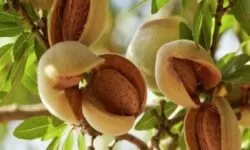
ALMOND: Benefits, Calories and Properties
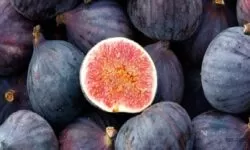
FIG: Benefits, Types and Properties

PERSIMMON: Origin, Properties and Benefits

CUCUMBER: Fruit or Vegetable. Benefits and Properties
Other Topics of Interest in ALPHAPEDIA

FREE BUSINESS COURSE

💚 WHAT IS BULLYING ?

FREE EYEBROW COURSE

FREE MASTER DEGREE IN HORTICULTURE

¿ HOW TO CLEAN MARBLE FLOORS ?

DEUTERONOMY 6:4
Watermelon Image
